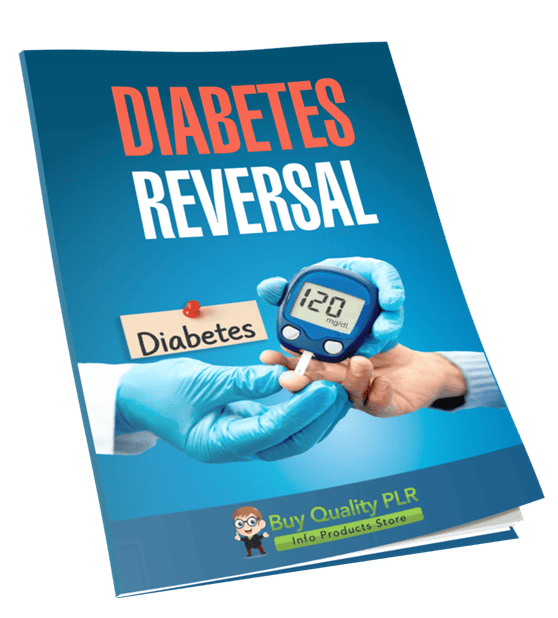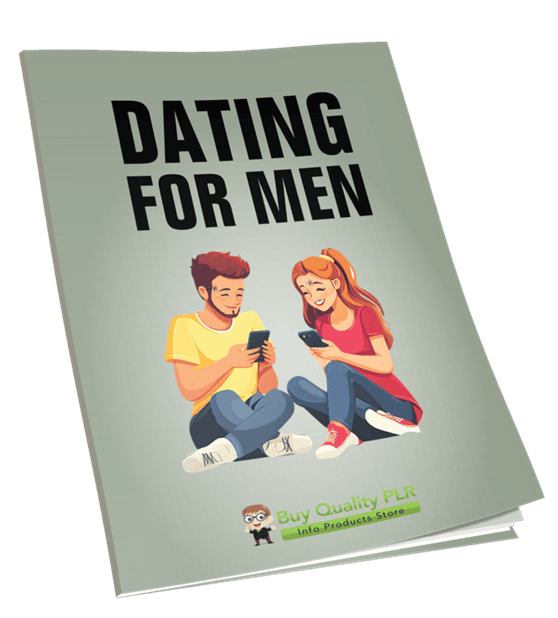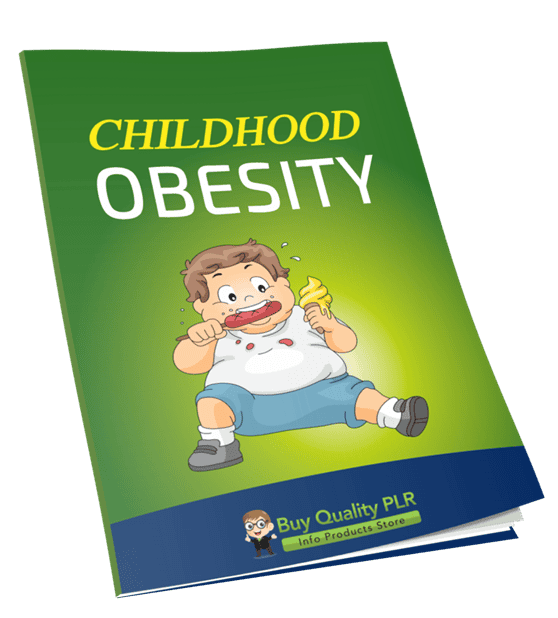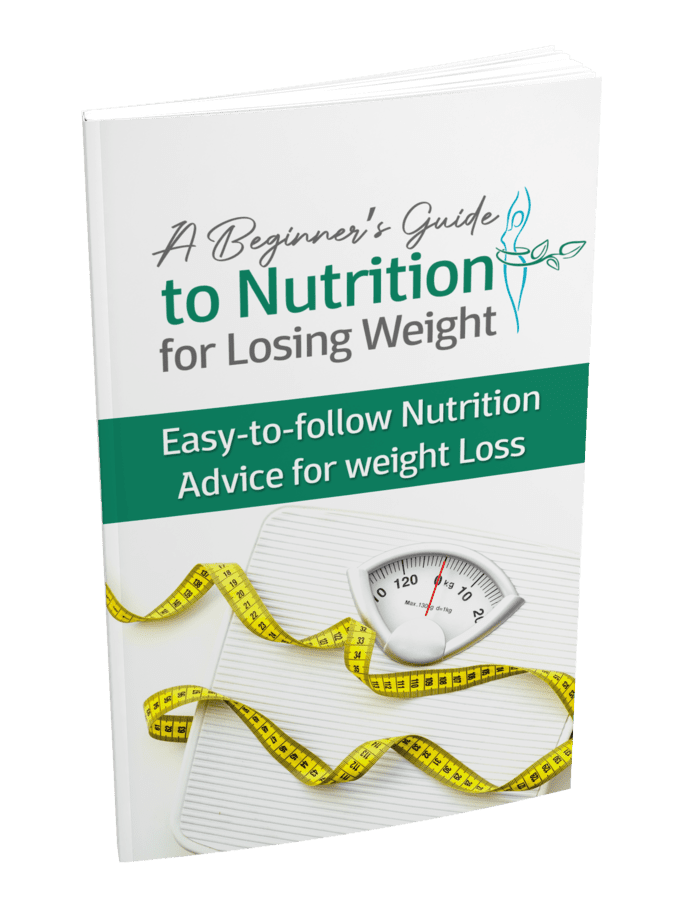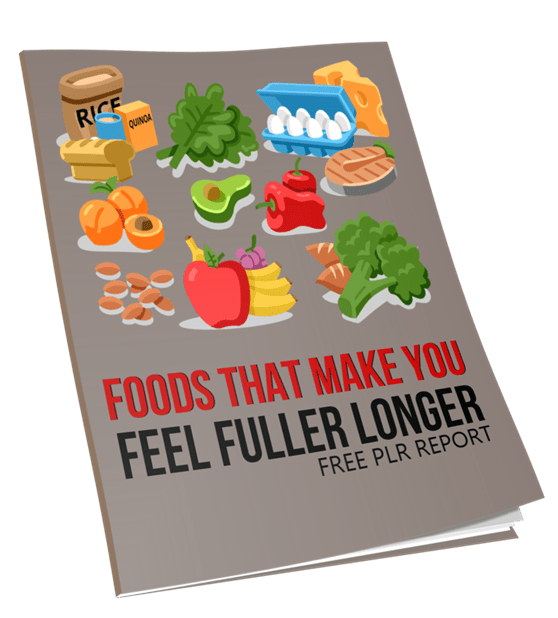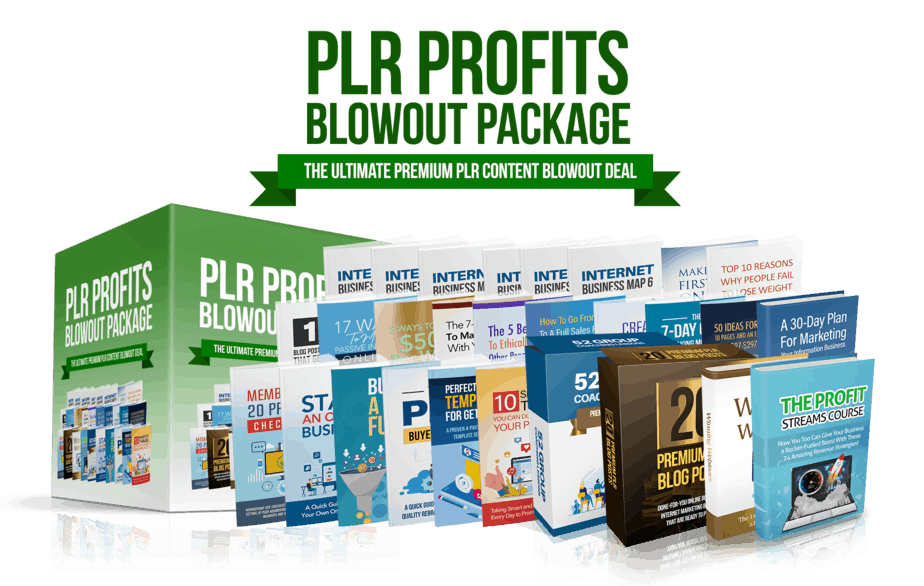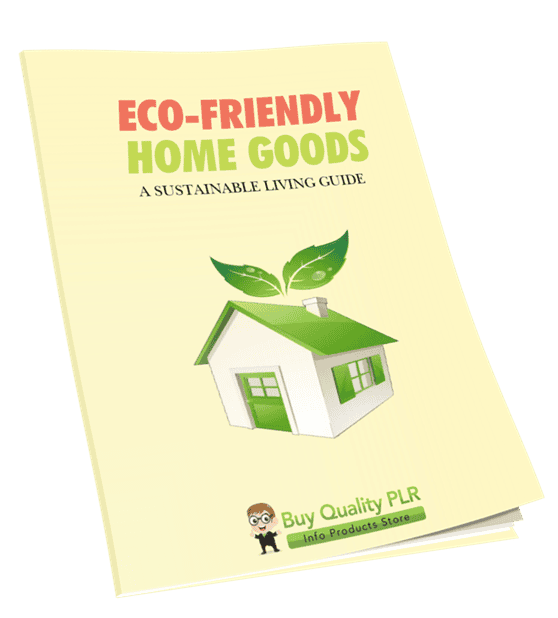
Eco-Friendly Home Goods PLR Course 23k Words
in Home Cleaning PLR , Home Improvement PLR Ebooks , PLR Checklists , PLR eBooks , PLR eCourses , Premium PLR , Premium PLR eBooks , Premium PLR Reports , Premium White Label Brandable PLR Coaching Courses , Private Label Rights ProductsChoose Your Desired Option(s)
has been added to your cart!
have been added to your cart!
#ecofriendlyliving #greenhome #plrcourse #sustainableliving #ecohomegoods #homegoods
Welcome to the Eco-Friendly Home Goods PLR Course, your ultimate guide to creating a more sustainable home! In this comprehensive course, you’ll learn how to make conscious decisions about the products you use, reduce waste, and transform your living space into a greener, more sustainable environment. By the end of this course, you will be equipped with practical knowledge and actionable steps to create an eco-friendly home that benefits both you and the planet.
This course covers everything from sustainable materials and waste reduction to energy-efficient solutions and eco-friendly shopping habits. Whether you’re a homeowner, renter, or someone passionate about sustainability, this course will provide valuable insights that make eco-friendly living simple and achievable. Let’s embark on this green journey together!
Presenting…
Eco-Friendly Home Goods PLR Course 23k Words
What’s Included in the Course:
The Eco-Friendly Home Goods PLR Course is divided into 5 modules, covering a variety of topics aimed at helping you integrate sustainability into your everyday life. With easy-to-follow steps and real-world examples, this course will guide you on how to make the best eco-conscious choices for your home.
Module 1: Understanding Eco-Friendly Home Goods
💡 Goal: Understand the core principles behind eco-friendly living and the importance of choosing sustainable products.
- Step 1: What Makes a Product Eco-Friendly?
Learn what qualifies a product as eco-friendly, from sustainable materials to energy-efficient designs. Understand how these products are designed to minimize environmental harm. - Step 2: The Environmental Impact of Household Goods
Discover how common household items—such as cleaning supplies, furniture, and electronics—contribute to pollution and waste. This section highlights the importance of making mindful choices to reduce your carbon footprint. - Step 3: Recognizing Green Certifications & Labels
Understand how to identify eco-friendly products using certifications like USDA Organic, Energy Star, and Fair Trade. This knowledge will help you choose sustainable options with confidence. - Step 4: Myths & Misconceptions About Eco-Friendly Living
Bust common myths such as “eco-friendly means expensive” or “green products don’t work well.” This section helps clear up misconceptions and highlights the benefits of living sustainably.
Module 2: Sustainable Materials & Alternatives
💡 Goal: Learn about sustainable materials and practical alternatives to common products in your home.
- Step 1: Choosing Natural & Recyclable Materials
Discover the best sustainable materials, such as bamboo, glass, and stainless steel, and understand why they are the go-to choices for eco-friendly home goods. - Step 2: Reducing Plastic Use in Everyday Items
Learn how to swap out single-use plastics with alternatives like reusable bags, glass food containers, and compostable packaging, contributing to a reduction in waste. - Step 3: Understanding Biodegradable vs. Recyclable
This section will clarify the differences between biodegradable, compostable, and recyclable materials, so you can properly dispose of items and avoid contaminating the environment. - Step 4: The Role of Upcycling & Repurposing
Explore creative ideas for repurposing old household items into new and functional décor or useful products, reducing waste while adding a unique touch to your home.
Module 3: Transforming Your Home into a Sustainable Space
💡 Goal: Explore simple and effective ways to create a sustainable living space in every room.
- Step 1: Eco-Friendly Kitchen Upgrades
Learn how to swap out plastic wraps for beeswax wraps, use compost bins, and upgrade to energy-efficient kitchen appliances. A few key changes can make your kitchen much greener. - Step 2: Sustainable Bathroom Essentials
Replace single-use plastics in your bathroom with eco-friendly alternatives, such as bamboo toothbrushes, shampoo bars, and reusable cotton pads. - Step 3: Green Cleaning Solutions
Discover how to make your own non-toxic cleaning products using ingredients like vinegar, baking soda, and essential oils. Save money and reduce chemicals in your home. - Step 4: Sustainable Bedroom & Living Spaces
Learn how to choose organic bedding, invest in second-hand furniture, and select eco-friendly paints to minimize your indoor air pollution.
Module 4: Energy Efficiency & Waste Reduction at Home
💡 Goal: Learn how to make your home more energy-efficient and reduce waste in everyday activities.
- Step 1: Smart Energy Use & Appliance Choices
Find out how to reduce your energy consumption by choosing energy-efficient appliances, using LED bulbs, and adopting small habits like unplugging devices when not in use. - Step 2: Water Conservation Tips for Every Room
Install low-flow showerheads, fix leaks, and consider using rainwater for gardening. Water is a precious resource, and conserving it can significantly reduce your environmental impact. - Step 3: Composting & Reducing Food Waste
Learn simple ways to compost your kitchen scraps and prevent food waste by planning meals efficiently. This section will provide you with actionable steps to help you contribute to a circular food system. - Step 4: Recycling Done Right
Understand the importance of separating and cleaning recyclables to ensure they’re processed properly. Learn the best practices for recycling to minimize contamination.
Module 5: Eco-Friendly Shopping & Lifestyle Habits
💡 Goal: Incorporate sustainable habits into your everyday life and shopping practices.
- Step 1: Shopping with a Green Mindset
Learn how to make conscious purchasing decisions, such as buying products with minimal packaging, supporting ethical brands, and opting for bulk purchases to reduce waste. - Step 2: DIY & Handmade Alternatives
Discover how to make homemade candles, natural air fresheners, and personal care products that are healthier for you and the environment. - Step 3: Supporting Sustainable Brands & Local Businesses
Understand why shopping locally can help reduce your carbon footprint and support small businesses that use ethical production methods. - Step 4: Building Long-Term Eco-Friendly Habits
Create a simple and sustainable action plan to make eco-friendly living a long-term part of your lifestyle. Learn how to inspire others to adopt green habits.
Bonus Materials Included:
- Eco-Friendly Home Goods Checklist (895 Words)
A quick reference guide summarizing the essential points of the course for easy access. - Eco-Friendly Home Goods FAQs (1,081 Words)
Answering common questions and providing additional tips to enhance your eco-friendly home experience. - Eco-Friendly Home Goods Salespage (632 Words)
A professionally crafted sales page that can help you promote and sell the course.
How to Profit from This Course:
The Eco-Friendly Home Goods PLR Course provides you with multiple opportunities to profit and grow:
- Sell the Course Directly: You can sell this course to individuals, families, or even home improvement and sustainability professionals looking to incorporate eco-friendly products into their lives.
- Bundle the Course: Combine this course with other eco-friendly or sustainability-related content to create premium bundles for more value.
- Create a Membership Site: Offer this course as part of a membership program, providing exclusive content, monthly tips, and other eco-friendly resources.
- Turn it into a Video Course: Break down the content into engaging videos and sell the course at a higher price point.
- Affiliate Marketing: Use the course as a lead magnet and promote it through affiliate marketing channels to generate more sales.
Licensing Terms:
With the Eco-Friendly Home Goods PLR Course, you have the right to:
- Sell it as-is or customize it to fit your branding.
- Break it into smaller pieces and sell them individually for $10-$20 each.
- Bundle it with other products for a premium offering ($47-$97).
- Create a membership site or eClass and generate recurring revenue.
What You Can’t Do:
- Resell PLR rights or relicense the content.
- Give it away for free in its entirety (you can use excerpts for blog posts or lead magnets).
- Offer 100% commission to affiliates; you can offer up to 75% commission.
Start Making a Difference with Eco-Friendly Choices Today!
Empower yourself and others to create a sustainable, eco-friendly home. Click here to purchase the Eco-Friendly Home Goods PLR Course for just $14.99 and start making a lasting positive impact on the environment, your home, and your family.
has been added to your cart!
have been added to your cart!
Here A Sample of Eco-Friendly Home Goods PLR Course
This course is designed to help you make informed choices about sustainable products, reduce waste, and create an eco-friendly home. Each module is packed with practical steps to guide you toward a greener lifestyle.
Let’s get started on your journey to an eco-conscious home!
Module 1: Understanding Eco-Friendly Home Goods
Before we dive into making changes, let’s first understand what “eco-friendly” really means and why it matters.
Step 1: What Makes a Product Eco-Friendly?
Introduction
As consumers, we often see labels like “eco-friendly,” “sustainable,” or “green” on products. But what do these terms really mean? Understanding the key characteristics of eco-friendly products is essential for making informed choices that reduce environmental harm and promote a healthier planet.
In this step, we will break down what makes a product truly eco-friendly by exploring:
- Sustainable Materials – What they are and why they matter
- Energy Efficiency – How products consume and conserve energy
- Ethical Sourcing – The importance of responsible production
By the end of this step, you will be able to identify and evaluate products based on these essential criteria.
1. Sustainable Materials: Choosing Earth-Friendly Resources
Sustainable materials are those that are responsibly sourced, renewable, or have a minimal environmental footprint. Here are some of the most commonly used sustainable materials and their benefits:
1.1 Renewable & Biodegradable Materials
- Bamboo: A rapidly renewable resource that requires no pesticides and regenerates quickly. Used in furniture, textiles, and kitchenware.
- Cork: Harvested from the bark of cork oak trees without harming the tree. Used in flooring, insulation, and accessories.
- Hemp: A highly sustainable plant that grows with minimal water and chemicals. Used in textiles, paper, and biodegradable plastics.
1.2 Recycled & Upcycled Materials
- Recycled Plastic: Reduces landfill waste by repurposing plastic waste into new products like clothing, furniture, and packaging.
- Recycled Metal: Aluminum and steel can be infinitely recycled without losing quality. Common in drink cans, car parts, and homeware.
- Upcycled Wood: Salvaged from old furniture or construction materials to create new products, reducing deforestation.
1.3 Non-Toxic & Chemical-Free Alternatives
- Organic Cotton: Grown without synthetic pesticides or fertilizers, making it safer for farmers, consumers, and the environment.
- Natural Dyes: Extracted from plants and minerals instead of synthetic chemicals, reducing water pollution in textile production.
- Plant-Based Packaging: Made from compostable materials like cornstarch or sugarcane pulp instead of petroleum-based plastics.
When choosing sustainable materials, look for internationally recognized certifications such as:
✔ Forest Stewardship Council (FSC) – Ensures sustainable forestry practices.
✔ Global Organic Textile Standard (GOTS) – Certifies organic fibers and eco-friendly production.
✔ Cradle to Cradle Certified® – Recognizes products designed for a circular economy.
2. Energy Efficiency: Reducing Carbon Footprint
Energy efficiency refers to how much energy a product consumes during its use and production. Lower energy consumption means a smaller carbon footprint and reduced reliance on fossil fuels.
2.1 Energy-Efficient Appliances & Electronics
- LED Lighting vs. Incandescent Bulbs: LEDs use up to 80% less energy and last significantly longer.
- Smart Thermostats: Reduce energy waste by automatically adjusting heating and cooling based on usage patterns.
- Energy-Efficient Refrigerators & Washing Machines: Look for products with high energy ratings and minimal standby power consumption.
2.2 Sustainable Manufacturing Processes
- Solar & Wind Energy in Factories: Brands investing in renewable energy sources during production reduce reliance on fossil fuels.
- Water-Efficient Production: Companies using closed-loop water recycling minimize water waste in textiles, paper, and electronics manufacturing.
- Minimal Waste Manufacturing: Processes that reduce offcuts, excess packaging, and emissions help lower environmental impact.
2.3 International Energy Certifications
When selecting energy-efficient products, check for certifications such as:
✔ ENERGY STAR® (USA, Canada, EU, Japan, Australia) – Identifies high-efficiency appliances and electronics.
✔ EU Energy Label (European Union) – Rates products from A+++ (most efficient) to G (least efficient).
✔ BEE Star Rating (India) – Provides energy efficiency ratings for home appliances.
By prioritizing energy-efficient products, consumers can lower electricity bills and contribute to a reduction in global greenhouse gas emissions.
3. Ethical Sourcing: Responsible Production & Fair Labor
Ethical sourcing ensures that raw materials and finished products are produced in a way that respects human rights, fair wages, and sustainable environmental practices.
3.1 Fair Trade & Ethical Labor Practices
- Fair Wages & Safe Working Conditions: Workers should receive fair pay and operate in safe environments, free from exploitation.
- No Child or Forced Labor: Ethical brands ensure their supply chains do not involve child labor, modern slavery, or unsafe working conditions.
- Transparency & Supply Chain Audits: Responsible companies conduct regular inspections and disclose their production processes.
3.2 Sustainable Farming & Harvesting Practices
- Organic & Regenerative Agriculture: Reduces soil degradation, promotes biodiversity, and avoids harmful chemicals.
- Sustainable Fishing & Aquaculture: Ensures fish populations are maintained without harming marine ecosystems.
- Deforestation-Free Products: Avoids raw materials sourced from illegal logging or endangered forests.
3.3 International Ethical Sourcing Certifications
To verify ethical sourcing, look for these globally recognized certifications:
✔ Fair Trade Certified™ – Ensures fair wages, safe conditions, and community development.
✔ Rainforest Alliance Certified™ – Supports sustainable farming and environmental protection.
✔ B Corp Certification – Recognizes businesses meeting high social and environmental standards.
By supporting ethically sourced products, consumers contribute to fair labor rights and responsible environmental stewardship worldwide.
Final Thoughts: Making Informed Eco-Friendly Choices
Now that you understand what makes a product eco-friendly, let’s summarize how you can identify and choose sustainable goods:
✅ Check Materials: Opt for renewable, recycled, or biodegradable materials.
✅ Assess Energy Use: Choose energy-efficient appliances and low-carbon products.
✅ Verify Ethical Sourcing: Look for fair labor practices and responsible production.
✅ Look for Certifications: Use international eco-labels to ensure product credibility.
By integrating these principles into your daily shopping habits, you can make a meaningful impact on both the environment and global communities.
Step 2: The Environmental Impact of Household Goods
Introduction
Every product we use in our homes has an environmental impact—from the resources used in production to how it’s disposed of. Common household goods, including cleaning supplies, kitchen items, electronics, and furniture, contribute to pollution, carbon emissions, and landfill waste. Understanding these impacts allows us to make more informed choices and reduce our ecological footprint.
In this step, we will examine:
- The Pollution Caused by Household Products – Air, water, and soil pollution
- Carbon Emissions and Climate Change – How household goods contribute to greenhouse gas emissions
- Landfill Waste and Resource Depletion – The long-term consequences of disposable products
By the end of this step, you will recognize the hidden environmental costs of everyday products and explore ways to minimize their impact.
1. Pollution Caused by Household Products
Pollution from household products affects the air we breathe, the water we drink, and the soil where our food grows. Many products release harmful chemicals during production, use, and disposal.
1.1 Air Pollution: Volatile Organic Compounds (VOCs) and Emissions
Many household products release volatile organic compounds (VOCs)—harmful chemicals that evaporate into the air, contributing to indoor and outdoor pollution.
Common sources of VOCs:
- Cleaning products (bleach, ammonia, aerosol sprays) – Release toxic fumes that affect indoor air quality.
- Paints and varnishes – Emit fumes that contribute to smog and respiratory problems.
- Synthetic air fresheners and scented candles – Contain petrochemicals that worsen air pollution.
💡 Solution: Choose non-toxic, fragrance-free, or plant-based alternatives that do not release harmful chemicals. Look for low-VOC or VOC-free labels.
1.2 Water Pollution: Chemical Waste and Microplastics
Many household products contaminate water sources when washed down drains or discarded improperly.
Major contributors to water pollution:
- Detergents and soaps with phosphates – Cause algae blooms that deplete oxygen in water bodies, killing marine life.
- Non-biodegradable wet wipes and sanitary products – Block sewage systems and end up in oceans.
- Microplastics from synthetic fabrics – Shed during laundry and pollute waterways, harming fish and aquatic ecosystems.
💡 Solution: Use phosphate-free detergents, biodegradable cleaning products, and natural fiber clothing that do not release microplastics.
1.3 Soil Contamination: Toxic Waste from Household Goods
Household waste that ends up in landfills can leach toxic chemicals into the soil, contaminating crops and groundwater.
Soil pollutants from household products:
- Batteries and electronic waste – Contain lead, mercury, and cadmium, which poison soil and water.
- Non-biodegradable plastics – Take centuries to decompose, releasing harmful additives into the environment.
- Pesticides and chemical fertilizers – Destroy soil biodiversity and contaminate food crops.
💡 Solution: Properly recycle electronics, choose compostable materials, and use natural fertilizers in gardening.
2. Carbon Emissions and Climate Change
The production, transportation, and disposal of household products generate carbon dioxide (CO₂) and other greenhouse gases that contribute to climate change.
2.1 Energy-Intensive Manufacturing Processes
Many household goods require large amounts of energy to produce, leading to high carbon emissions.
Major carbon emitters:
- Aluminum cans and single-use plastics – Require significant energy to extract, refine, and produce.
- Fast furniture and mass-produced clothing – Often made from non-renewable materials using carbon-intensive manufacturing.
- Home appliances – Manufacturing and transportation of large appliances result in high CO₂ emissions.
💡 Solution: Choose recycled materials, support sustainable brands, and invest in durable, long-lasting products instead of disposables.
2.2 Transportation and Packaging Waste
Many household goods travel thousands of kilometers before reaching consumers, increasing their carbon footprint due to transportation emissions.
Key factors in high transportation emissions:
- Overseas manufacturing – Imported goods require extensive fuel for shipping.
- Excessive packaging – Plastic wraps, Styrofoam, and cardboard add to waste and emissions.
- Frequent online shopping deliveries – Multiple shipments increase fuel consumption.
💡 Solution: Buy locally made products, minimize packaging waste, and group online orders to reduce transportation impact.
2.3 Household Energy Consumption
Some household products continue to consume energy even when not in use, leading to unnecessary carbon emissions.
Common energy-draining household items:
- Standby power in electronics – Devices like TVs, microwaves, and chargers use power even when turned off.
- Inefficient appliances – Older refrigerators, washing machines, and air conditioners consume excessive electricity.
- Incandescent bulbs – Waste energy compared to LED alternatives.
💡 Solution: Unplug devices when not in use, upgrade to energy-efficient appliances, and switch to LED lighting.
3. Landfill Waste and Resource Depletion
Many household items are designed for disposal, leading to growing landfills and depletion of natural resources.
3.1 Disposable vs. Reusable Products
Single-use products contribute to landfill overflow and waste of natural resources.
Examples of common disposable items:
- Paper towels and napkins – Require deforestation and energy to produce.
- Plastic cutlery, plates, and straws – Take centuries to break down.
- Disposable diapers and sanitary products – Generate millions of tons of waste yearly.
💡 Solution: Use reusable alternatives like cloth napkins, metal straws, and menstrual cups.
3.2 Electronic Waste (E-Waste) Crisis
E-waste is the fastest-growing waste category, with millions of tons discarded yearly.
Major contributors to e-waste:
- Smartphones and laptops – Short lifespans lead to frequent replacements.
- Batteries and chargers – Contain hazardous chemicals that pollute the environment.
- Televisions and home appliances – Often discarded instead of repaired.
💡 Solution: Repair devices when possible, recycle electronics properly, and buy refurbished products.
3.3 Overconsumption and the Throwaway Culture
Mass production and marketing encourage buying more than we need, leading to excessive waste.
Signs of overconsumption:
- Fast fashion trends – Cheap, low-quality clothing that is discarded quickly.
- Impulse buying – Purchasing unnecessary household gadgets.
- Frequent furniture replacements – Low-cost, low-durability furniture creates excess waste.
💡 Solution: Adopt a minimalist approach, buy quality over quantity, and donate or repurpose items instead of throwing them away.
Final Thoughts: Rethinking Household Consumption
Now that you understand the environmental impact of household goods, let’s summarize key takeaways:
✅ Reduce Pollution: Choose non-toxic and biodegradable products to protect air, water, and soil.
✅ Lower Carbon Emissions: Buy energy-efficient appliances, minimize transportation emissions, and avoid wasteful packaging.
✅ Cut Down on Landfill Waste: Use reusable alternatives, recycle electronics, and shift away from disposable culture.
By making small, mindful choices, we can reduce our ecological footprint and create a more sustainable home.
Step 3: Recognizing Green Certifications & Labels
Introduction
With an increasing number of products claiming to be “eco-friendly,” “natural,” or “green,” it can be difficult to determine which ones are truly sustainable. To make informed decisions, it’s important to understand eco-certifications and labels—official seals that indicate a product meets specific environmental, ethical, and health standards.
In this step, you will:
- Understand What Green Certifications Mean – Learn why certifications matter and how they help you choose better products.
- Identify Key International Green Certifications – Get familiar with globally recognized labels, including USDA Organic, Energy Star, Fair Trade, and more.
- Differentiate Between Genuine Certifications and Greenwashing – Recognize misleading labels and marketing tricks that can deceive consumers.
- Apply This Knowledge When Shopping – Learn how to read labels, research certifications, and make sustainable choices.
By the end of this step, you’ll confidently navigate eco-labels and select products that align with your values and sustainability goals.
1. Understanding What Green Certifications Mean
Eco-certifications serve as official endorsements that a product meets established sustainability criteria. These certifications are granted by independent organizations that evaluate products based on environmental impact, ethical sourcing, and health standards.
1.1 Why Green Certifications Matter
- Ensure Environmental Responsibility – Certified products follow eco-friendly manufacturing, sourcing, and disposal practices.
- Promote Ethical Business Practices – Many certifications ensure fair wages, safe working conditions, and humane treatment of workers and animals.
- Protect Consumer Health – Some certifications indicate that products are free from toxic chemicals, pesticides, or synthetic additives.
- Reduce Greenwashing Risks – Official labels help you distinguish between genuinely eco-friendly products and misleading claims.
💡 Tip: Always look for official logos from recognized certification bodies rather than relying on vague marketing terms like “natural” or “eco-friendly.”
2. Identifying Key International Green Certifications
There are numerous eco-labels worldwide, but some are more credible and widely recognized than others. Here are some of the most important certifications to look for when shopping for sustainable home goods:
2.1 USDA Organic (United States Department of Agriculture – Organic Certification)
✅ What It Means:
- Ensures agricultural products are grown without synthetic pesticides, herbicides, or genetically modified organisms (GMOs).
- Guarantees organic farming practices that improve soil health and biodiversity.
- Found on food products, textiles (organic cotton), and personal care items.
💡 Where to Look: Found in the United States and recognized internationally for organic food and textile standards.
2.2 Energy Star (U.S. Environmental Protection Agency & Department of Energy)
✅ What It Means:
- Indicates high energy efficiency for appliances, lighting, electronics, and even homes.
- Products with this label consume less electricity, reducing carbon emissions and utility bills.
- Found on refrigerators, washing machines, dishwashers, air conditioners, and LED bulbs.
💡 Where to Look: Common in the United States, Canada, Australia, and the EU for energy-saving appliances.
2.3 Fair Trade Certified (Fair Trade International & Fair Trade USA)
✅ What It Means:
- Guarantees fair wages, safe working conditions, and no child labor.
- Ensures farmers and artisans receive fair compensation for their work.
- Found on coffee, tea, chocolate, clothing, handicrafts, and home decor.
💡 Where to Look: Recognized globally, with Fair Trade labels appearing on ethically sourced products.
2.4 FSC (Forest Stewardship Council) Certified
✅ What It Means:
- Ensures wood and paper products come from responsibly managed forests.
- Supports sustainable forestry practices to prevent deforestation.
- Found on furniture, paper, toilet paper, and packaging materials.
💡 Where to Look: Global certification appearing on wood-based products and packaging materials.
2.5 Global Organic Textile Standard (GOTS)
✅ What It Means:
- Ensures textiles (cotton, wool, hemp) are grown organically and processed without toxic dyes or chemicals.
- Guarantees socially responsible labor practices in textile production.
- Found on organic clothing, bedding, and towels.
💡 Where to Look: International standard found on organic textiles and apparel.
2.6 EU Ecolabel (European Union Environmental Label)
✅ What It Means:
- Certifies products that meet strict environmental impact criteria throughout their lifecycle.
- Found on cleaning products, personal care items, paints, and furniture.
- Ensures low pollution, energy efficiency, and reduced waste production.
💡 Where to Look: Found throughout Europe and recognized globally.
2.7 B Corporation (B Corp Certification)
✅ What It Means:
- Awarded to companies that meet high social and environmental performance standards.
- Ensures businesses prioritize sustainability, worker well-being, and ethical supply chains.
- Found on eco-friendly brands across various industries.
💡 Where to Look: International certification seen on ethical and sustainable brand packaging.
3. Differentiating Between Genuine Certifications and Greenwashing
Greenwashing is when companies mislead consumers into believing their products are eco-friendly, even when they are not. Some businesses use fake or vague labels to appear sustainable without meeting real environmental standards.
3.1 How to Spot Greenwashing
- Vague terms – Words like “green,” “eco-friendly,” or “natural” without certification.
- Fake logos – Some brands create their own symbols that look official but have no credibility.
- Hidden trade-offs – A product may be labeled “biodegradable” but still contain harmful chemicals.
- Lack of transparency – Companies that do not disclose full details of their sustainability practices.
💡 Solution: Always research the certification body, check for official logos, and visit the certifier’s website to verify authenticity.
4. Applying This Knowledge When Shopping
Now that you understand key green certifications, here’s how to use this information in daily life:
4.1 Checking Labels in Stores
- Look for trusted certifications on product packaging before buying.
- Prioritize products with multiple sustainability labels (e.g., USDA Organic + Fair Trade).
- Verify certification numbers on official certification websites when in doubt.
4.2 Choosing Eco-Friendly Online Products
- Search for certified eco-friendly brands that display recognized labels.
- Read customer reviews to check for greenwashing claims.
- Look for detailed product descriptions that explain sustainability efforts.
4.3 Supporting Certified Sustainable Brands
- Purchase from brands that hold certifications like B Corp, Fair Trade, or FSC.
- Support local or ethical businesses that align with environmental values.
- Educate others on choosing truly sustainable products over greenwashed alternatives.
Final Thoughts: Making Confident Sustainable Choices
Now that you are familiar with eco-certifications and labels, let’s review the key takeaways:
✅ Recognize trusted green certifications like USDA Organic, Energy Star, Fair Trade, FSC, and GOTS.
✅ Differentiate between real certifications and misleading greenwashing tactics.
✅ Apply this knowledge while shopping to ensure you choose genuinely sustainable products.
By prioritizing products with credible eco-certifications, you can contribute to a greener, healthier, and more ethical world.
Step 4: Myths & Misconceptions About Eco-Friendly Living
Introduction
Many people hesitate to adopt an eco-friendly lifestyle due to common myths and misconceptions surrounding sustainability. Some believe that going green is too expensive, inconvenient, or ineffective. Others assume that individual actions don’t make a significant impact.
In this step, we will:
- Identify Common Myths About Eco-Friendly Living – Address misconceptions that prevent people from making sustainable choices.
- Debunk These Myths With Facts – Provide evidence-based insights to clarify misunderstandings.
- Understand the Real Benefits of Going Green – Explore the financial, environmental, and health benefits of sustainable living.
- Learn How to Take Practical Steps Despite Misconceptions – Discover how small, meaningful actions can make a difference without breaking the bank or sacrificing quality.
By the end of this step, you will be equipped to confidently embrace an eco-friendly lifestyle and educate others on the realities of sustainable living.
1. Identifying Common Myths About Eco-Friendly Living
Misinformation can discourage people from making greener choices. Below are some of the most common myths about sustainability:
1.1 “Eco-Friendly Living is Too Expensive”
Many people assume that sustainable products cost significantly more than conventional options.
1.2 “Green Products Don’t Work as Well as Traditional Ones”
Some believe that eco-friendly products, such as natural cleaning supplies, biodegradable packaging, or solar-powered gadgets, are less effective than their conventional counterparts.
1.3 “Sustainable Choices Don’t Make a Real Difference”
A common belief is that individual efforts, like reducing plastic use or saving energy, don’t have a meaningful impact on the planet.
1.4 “Eco-Friendly Living is Inconvenient and Requires Major Lifestyle Changes”
Many people think that going green means giving up comfort, convenience, or their favorite products.
1.5 “Recycling is Enough to Be Sustainable”
Some believe that simply recycling plastic and paper is enough to be eco-friendly, ignoring the importance of reducing and reusing.
Now, let’s break down these misconceptions with facts.
2. Debunking These Myths With Facts
2.1 Myth: “Eco-Friendly Living is Too Expensive” → Reality: Sustainable Living Can Save You Money
- While some organic or sustainable products may have a higher upfront cost, they often last longer and save money over time.
- Energy-efficient appliances, like LED bulbs and Energy Star-rated electronics, reduce electricity bills.
- Using reusable products (e.g., cloth napkins, stainless steel water bottles) eliminates the need for disposable alternatives, leading to long-term savings.
- Many eco-friendly habits, such as reducing energy and water usage, actually help cut household expenses.
💡 Example: A high-quality reusable water bottle may cost more initially than buying bottled water, but over time, it saves money and reduces plastic waste.
2.2 Myth: “Green Products Don’t Work as Well as Traditional Ones” → Reality: Many Are Just as Effective, If Not Better
- Eco-friendly cleaning products made from plant-based ingredients can be just as powerful as chemical cleaners while being safer for health.
- Solar-powered devices provide reliable energy, and modern solar panels can generate enough electricity to power entire homes.
- Sustainable fashion brands use high-quality, durable materials that often outlast fast fashion clothing.
💡 Example: Vinegar and baking soda can effectively clean surfaces and remove stains without the harmful chemicals found in many traditional cleaning products.
2.3 Myth: “Sustainable Choices Don’t Make a Real Difference” → Reality: Every Action Contributes to Global Change
- Small actions add up over time—if millions of people reduce single-use plastics, it leads to a significant reduction in ocean pollution.
- Companies respond to consumer demand—as more people choose eco-friendly products, industries shift toward sustainable practices.
- Sustainable habits preserve natural resources, ensuring future generations have access to clean water, air, and biodiversity.
💡 Example: One reusable shopping bag can replace over 500 plastic bags per year, reducing plastic waste and pollution.
2.4 Myth: “Eco-Friendly Living is Inconvenient and Requires Major Lifestyle Changes” → Reality: Small, Easy Changes Can Make a Big Impact
- Sustainability doesn’t mean giving up comfort—it’s about making better choices with minimal effort.
- Many eco-friendly swaps are simple, such as switching to LED bulbs, using a reusable coffee cup, or buying local produce.
- New technology and sustainable innovations make green living easier than ever, with smart thermostats, refillable products, and eco-friendly packaging.
💡 Example: Bringing your own reusable bag to the grocery store requires almost no effort but significantly reduces plastic waste.
2.5 Myth: “Recycling is Enough to Be Sustainable” → Reality: Reducing & Reusing Are Even More Important
- Not all recyclables actually get recycled—many end up in landfills due to contamination or lack of facilities.
- The best way to reduce waste is to limit unnecessary consumption in the first place.
- The “Reduce, Reuse, Recycle” model emphasizes that reducing and reusing are more impactful than just recycling.
💡 Example: Instead of buying bottled water and recycling the plastic, switching to a reusable water bottle eliminates waste altogether.
3. Understanding the Real Benefits of Going Green
Switching to eco-friendly habits isn’t just about helping the environment—it comes with personal benefits too.
✅ Financial Benefits – Energy-efficient products save money on electricity bills, and reusable items reduce spending on disposables.
✅ Health Benefits – Organic foods, chemical-free cleaning products, and eco-conscious materials reduce exposure to toxins.
✅ Convenience – Many sustainable products are higher quality and last longer, reducing the need for frequent replacements.
✅ Positive Global Impact – Every eco-conscious choice helps protect natural resources, wildlife, and communities.
4. How to Take Practical Steps Despite Misconceptions
Now that you understand the truth behind these myths, here’s how to apply your knowledge:
4.1 Start with Small, Cost-Effective Changes
- Replace disposable items with reusable alternatives (e.g., glass food containers, bamboo toothbrushes).
- Unplug electronics when not in use to save energy.
- Switch to LED light bulbs to reduce electricity costs.
4.2 Test Eco-Friendly Products to See Their Effectiveness
- Try natural cleaning solutions like vinegar and baking soda.
- Use organic personal care products and see if they work as well as (or better than) traditional options.
- Experiment with solar-powered devices, like outdoor lights or phone chargers.
4.3 Focus on Actions That Have the Biggest Impact
- Cut back on single-use plastics—bring a reusable bag, water bottle, and coffee cup.
- Choose energy-efficient appliances when upgrading household items.
- Buy from sustainable and ethical brands that use eco-friendly materials.
4.4 Educate Others and Challenge Greenwashing
- Share facts with family and friends to encourage informed decisions.
- Research brands to support truly sustainable companies.
- Be mindful of misleading advertising and demand transparency from businesses.
Final Thoughts: Empowering Yourself With Knowledge
By debunking these myths, you can confidently embrace eco-friendly living and inspire others to do the same. Remember:
✅ Sustainable living doesn’t have to be expensive—many green habits save money in the long run.
✅ Eco-friendly products work just as well as conventional ones, if not better.
✅ Individual actions add up, influencing industries and policies.
✅ Going green is easy with small, practical steps.
✅ Recycling is important, but reducing and reusing have an even greater impact.
We’re also giving these extra bonuses
Eco-Friendly Home Goods – Checklist

Eco-Friendly Home Goods – FAQs

Eco-Friendly Home Goods – Salespage Content
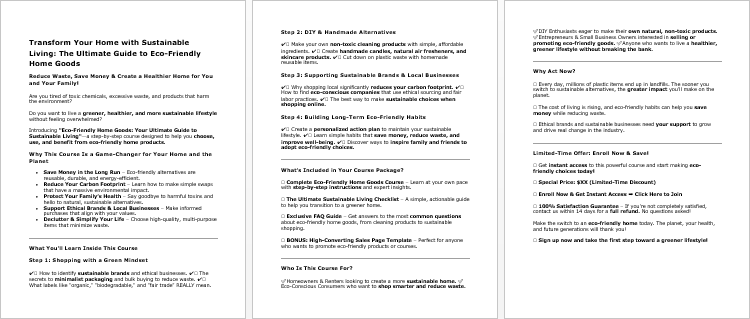
Package Details:
Word Count: 20 546 Words
Number of Pages: 103
Eco-Friendly Home Goods – Bonus Content
Checklist
Word Count: 934 words
FAQs
Word Count: 1066 words
Salespage Content
Word Count: 670 words
Total Word Count: 23 154 Words
Your PLR License Terms
PERMISSIONS: What Can You Do With These Materials?
Sell the content basically as it is (with some minor tweaks to make it “yours”).
If you are going to claim copyright to anything created with this content, then you must substantially change at 75% of the content to distinguish yourself from other licensees.
Break up the content into small portions to sell as individual reports for $10-$20 each.
Bundle the content with other existing content to create larger products for $47-$97 each.
Setup your own membership site with the content and generate monthly residual payments!
Take the content and convert it into a multiple-week “eclass” that you charge $297-$497 to access!
Use the content to create a “physical” product that you sell for premium prices!
Convert it to audios, videos, membership site content and more.
Excerpt and / or edit portions of the content to give away for free as blog posts, reports, etc. to use as lead magnets, incentives and more!
Create your own original product from it, set it up at a site and “flip” the site for megabucks!
RESTRICTIONS: What Can’t You Do With These Materials?
To protect the value of these products, you may not pass on the rights to your customers. This means that your customers may not have PLR rights or reprint / resell rights passed on to them.
You may not pass on any kind of licensing (PLR, reprint / resell, etc.) to ANY offer created from ANY PORTION OF this content that would allow additional people to sell or give away any portion of the content contained in this package.
You may not offer 100% commission to affiliates selling your version / copy of this product. The maximum affiliate commission you may pay out for offers created that include parts of this content is 75%.
You are not permitted to give the complete materials away in their current state for free – they must be sold. They must be excerpted and / or edited to be given away, unless otherwise noted. Example: You ARE permitted to excerpt portions of content for blog posts, lead magnets, etc.
You may not add this content to any part of an existing customer order that would not require them to make an additional purchase. (IE You cannot add it to a package, membership site, etc. that customers have ALREADY paid for.)
Share Now!

